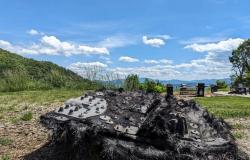A Florida family is suing NASA after a piece of debris from the International Space Station fell to Earth and punched a hole in its roof, a rare case that raises questions about who is responsible for space debris as nations, Private companies and billionaires compete to build the burgeoning space economy.
KEY FACTS
A family from Naples, Florida, is seeking $80,000 from NASA for property and business damages, emotional and mental distress and other costs after metal scrap from the International Space Station fell to Earth and damaged their home earlier this year.
NASA, which collected and analyzed the metal object from the family home, identified the cylinder as part of a cargo pallet it released from the space station in 2021 believing it would burn up upon re-entering Earth’s atmosphere.
As this is a “US vs. US matter” regarding NASA waste and damage in Florida, McGill University associate professor Andrea Harrington told Forbes that the matter will be governed by domestic law of the United States, “like any other case of harm caused by the government to private parties.”
Harrington, who is also co-director of McGill’s Air and Space Law Institute, said there is an entire treaty addressing the issue of harm to people or property caused by another country’s actions in space.
The United States is a party to this treaty, known as the Outer Space Treaty, and if the material had landed in another country, Harrington said, the U.S. government itself would be responsible for paying that country’s government, and any payments to individuals would be handled. internally by that country.
Under the treaty, the United States would also be obligated to pay for damages caused by private American companies, although the company or its insurers would then pay the US government in accordance with national law.
HOW WILL NASA RESPOND TO THE DEMAND?
The family’s Florida attorney, Mica Nguyen Worthy, said their lawsuit is important because it will set a precedent for how the agency will handle incidents like this in the future. NASA has six months to respond under US law. Worthy has urged the agency, and by extension the US government, to respond in the same way that international law would require if the object had fallen abroad. “If the incident had occurred overseas and someone in another country had been harmed by the same space debris as in the Otero case, the United States would have been absolutely responsible for paying for those damages,” Worthy said in a statement, adding that The government has the opportunity to set a standard for what “responsible, safe and sustainable space operations” should be. Harrington said he “very doubts there is a need for anyone to go to court,” explaining that it is best for “NASA, both financially and in terms of public perception, to provide a reasonable payment without the need for a lawsuit and I think that they will do it”.
AGAINST
Christopher Newman, a professor of space law and policy at Northumbria University in the United Kingdom, told Forbes that fault for damage from space debris like this does not need to be proven for the state that launched it to be liable to compensate. All that is required is to prove that the damage has been caused by the space object. However, Newman said the object’s origin on the International Space Station could complicate matters, since it was done through an international partnership that stipulates that each partner (the United States, Russia, European governments, Japan and Canada) consult on liability and defense of claims under international treaties.
WHAT TO KEEP IN MIND
Laws regulating space “were sufficient when space activity was an exclusive and expensive business,” Newman said. The laws are not often invoked (the Soviet Union paid Canada in the 1980s after a satellite burned up over the country), but in recent years, Newman said, it has become cheaper to access space and build the type of hardware sent there, with a net result of more and more hardware being placed in orbit. Debris is a threat to both humanity’s ability to access space, objects already in space (at high speeds, collisions with even very small objects can be catastrophic) and those on Earth. In 2022, scientists estimated there was a 1 in 10 chance of casualties from runaway rockets falling to Earth over the next decade. “This is testing every aspect of the current regulatory and legal regime governing space activity, as it was conceived for a different time and a much narrower scope of human activity,” Newman said, adding that the types of institutions and processes needed to address complaints and enforce the law.
CRUCIAL APPOINTMENT
“The problem of debris crashing into the Earth and causing damage is pretty marginal and low risk, in the grand scheme of things,” Harrington said, a sentiment echoed by Newman. “The biggest problem with space debris is the amount of debris that accumulates in low Earth orbit, creating hazards that could lead to collisions and debris cascades, making it much more difficult to carry out activities safely.” safe in space,” Harrington said. “One of the big problems is that it is not economically viable to remove much of the debris that currently exists in orbit, so most current efforts are focused on mitigating the creation of new debris.”
BIG NUMBER
9,000 metric tons. That’s at least how much orbital debris was in Earth’s orbit in January 2022, according to NASA. More than 25,000 of the objects that make up this mass are larger than 10 cm, according to NASA, and an estimated 500,000 are between 1 cm and 10 cm in diameter. There are more than 100 million space debris particles larger than 1 mm in size.
This article was originally published by Forbes US.
You may be interested in Forbes in Spanish: Why PayPal’s recovery plan could take years, if it ever works





